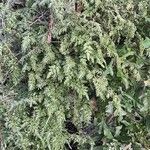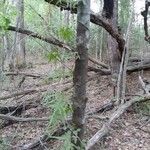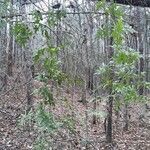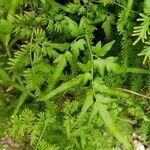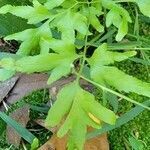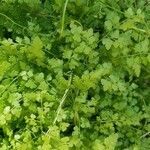Rhizome widely creeping, dichotomously branched, 2-5 mm in diam., densely clothed with dark brown hairs, fronds commonly 5-10 mm apart. Juvenile fronds erect, first branching an unequal dichotomy (?always), two main branches of large fronds bipinnate, deltoid in outline, with palmatisect pinnae, pinna margins doubly serrate. Rachis of climbing fronds hardly ca. 2 mm in diam., glabrous except for minute hairs on flattened adaxial surface between narrow wings; primary rachis branches 3-10 mm, dormant apex covered with pale hairs; secondary branches of fronds on young or stunted plants pinnate, on well-grown fronds bipinnate or tripinnate, deltoid in outline, commonly ca. 12 cm long and wide, rachises densely shortly hairy on adaxial surface and with fewer longer hairs elsewhere; sterile tertiary pinnae of lower rachis branches palmate with 5-7 lobes, middle lobe much longer than lateral lobes, tertiary pinnae higher up frond 3-lobed with an elongate middle lobe or pinnate with small oblique and often lobed quaternary pinnae and a usually deltoid-pinnatisect terminal pinna ca. 3 cm, margins acutely biserrate, apex obtuse or subacute; stalks of pinnae up to 3 mm, never articulate or thickened at apex; costae usually with long scattered hairs, veins and surfaces usually glabrous but sometimes shortly hairy; fertile secondary branches tripinnate, pinnae smaller than sterile pinnae, sorophores 2-12 mm; indusia glabrous or with few hairs if lamina hairy; spores finely low tuberculate to verrucose with prominent laesurae.
Rhizome short-creeping. Juvenile fronds unknown. Rachis sparsely pubescent, subterete, flattened on 1 side with ridged edges; primary rachis branches c. 2 mm long; secondary pinnae broadly lanceolate-triangular, 10–17 cm long, 7–17 cm wide, often broader than long, 3-pinnate; pinnule stalks reducing in length towards pinna apex; basal tertiary pinnules 3–8 cm long, 2.5–8 cm wide; ultimate pinnules ovate, lanceolate to triangular; sterile ones fused, palmately-lobed; terminal lobe much longer, membranous, sparsely pubescent; base ±hastate; margins entire or crenulate; veins free; sporogenous pinnules smaller and more finely dissected than sterile ones. Sporogenous lobes 1–5 mm long.
Stems creeping. Leaves to ca. 3(-30) m. Petioles borne 2-7 mm apart, 10-35 cm. Sterile pinnae on 1.5-3.5 cm stalks, triangular to lanceolate, 2-3-pinnate, 6-15 × 5.5-15 cm; ultimate segments lanceolate, lobed or divided proximally; lobes usually acute at tip and directed toward apex; segment apices long-attenuate to acute; segments not articulate to petiolules, not leaving wiry stalks when detached; blade tissue pubescent abaxially with short, curved hairs. Fertile pinnae on 1-2 cm stalks, lanceolate-triangular, 2-3-pinnate, 5-18 × 4-14 cm; ultimate segments ovate to lanceolate, fringed with fertile lobes, otherwise similiar to sterile segments.
A climbing fern. It is a herb. It forms dense climbing patches to 3 m tall. The rootstock is long and creeping and much branched. The fronds are bright green. The leaves are compound. They are divided 3 times. The leaflets are 5-12 cm long by 1-1.5 cm wide. There are teeth along the edge. The sterile fronds are more broad. The fertile segments are 0.6-1.5 cm long. The spore bodies are large and in two rows. They can be carried in the wind.
Rhizome creeping, up to 4 mm in diam. Fronds up to 10 m long. Rachis brown, glabrous, twining, with secondary rachises up to 5 mm long at irregular intervals, dichotomously branched, with an aborted, densely haired bud centrally, ultimate branches with alternate to 2-pinnate. Pinnae: sterile up to 40 mm long, proximally basiscopically developed, denticulate; fertile up to 2-pinnate-pinnatifid, with linear fertile segments up to 9 mm long.
